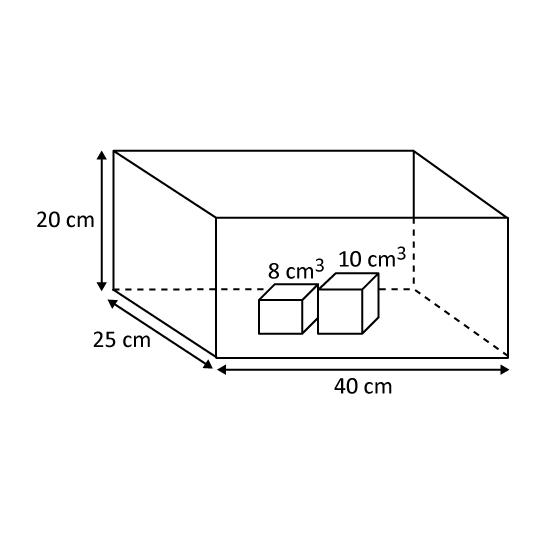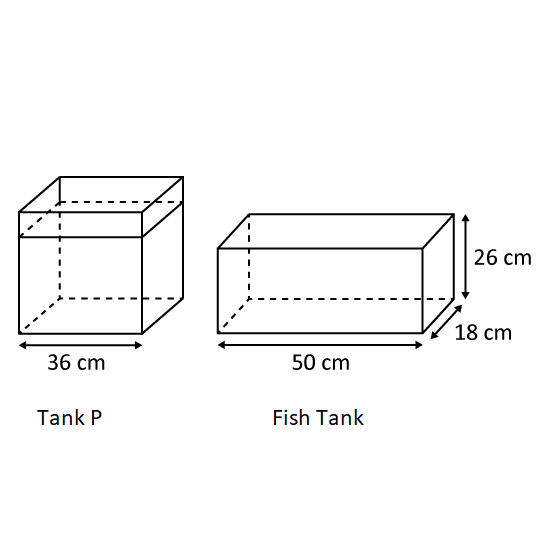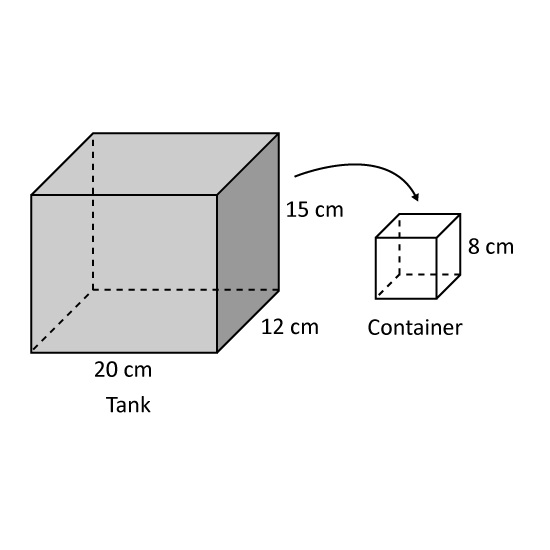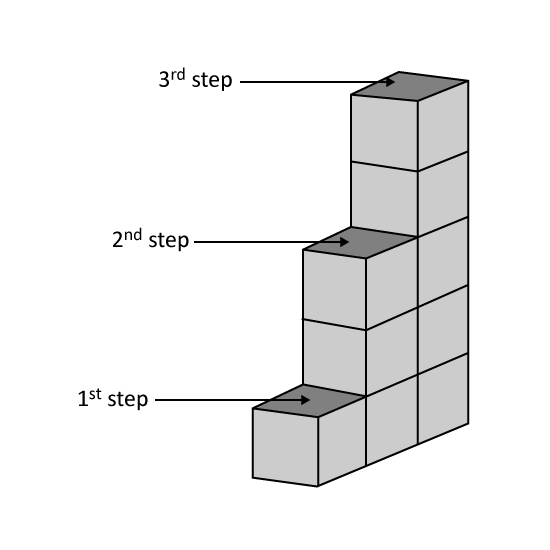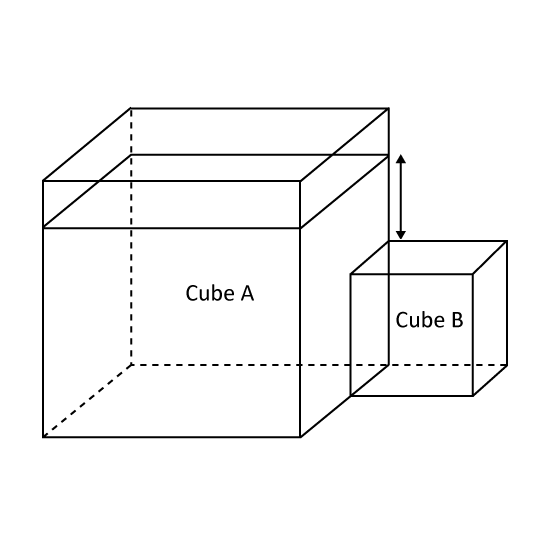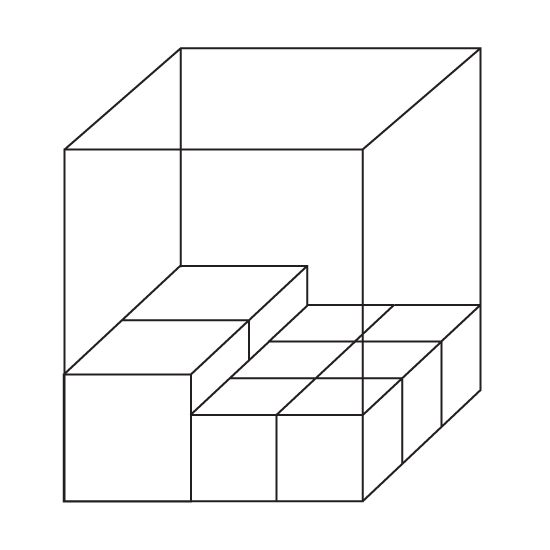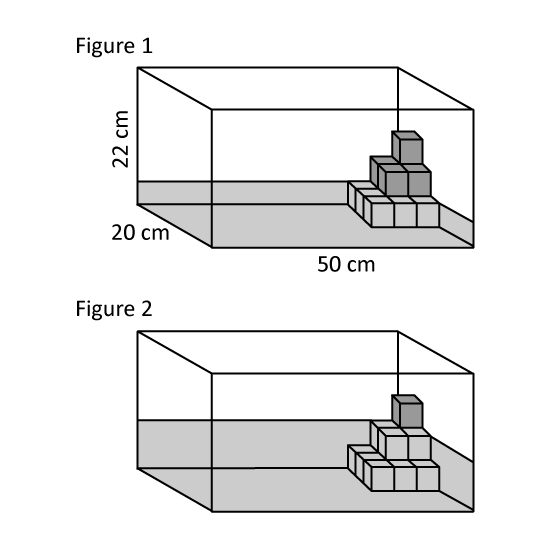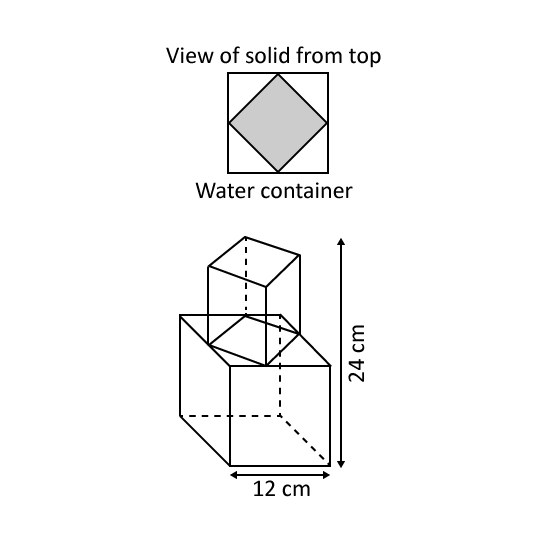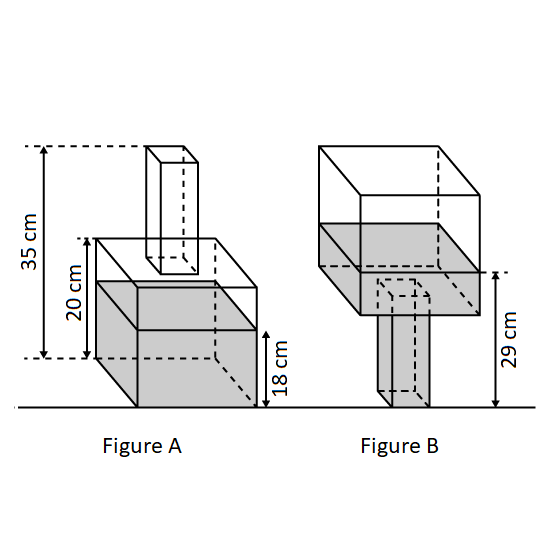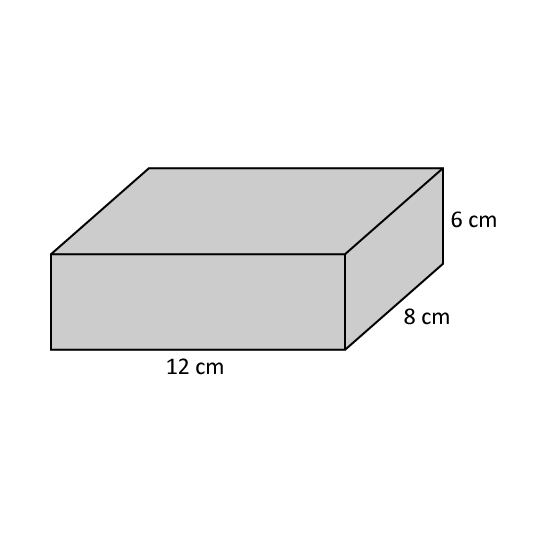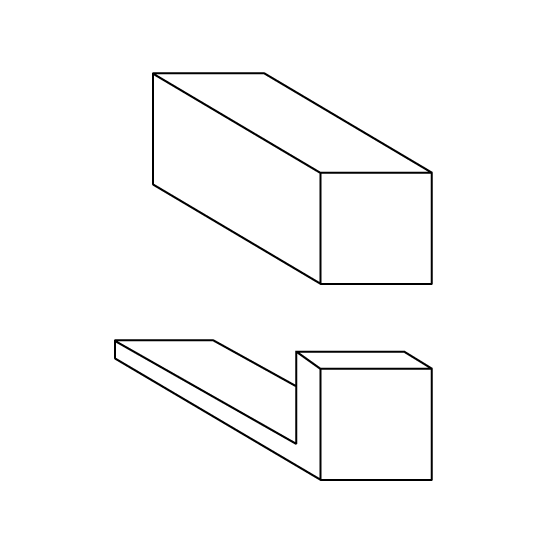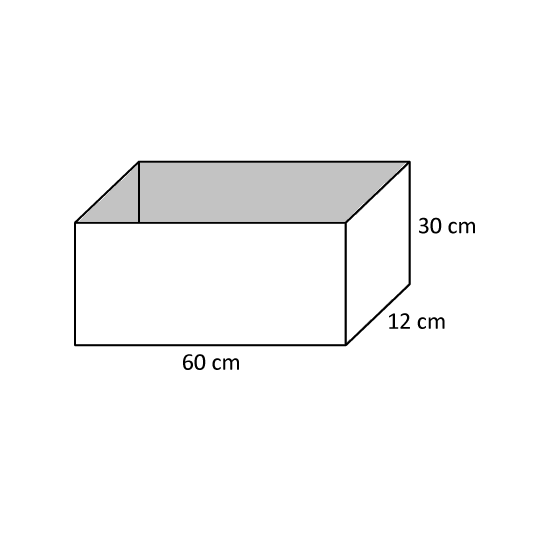Level 3
A large cubical container of side 60 cm was filled with fruit juice up to 30% of its capacity. After 5 full jugs of fruit juice were removed from it, the level of fruit juice in the container dropped by
14 cm. The remaining fruit juice was then drained out through a tap found at the bottom of the container at a rate of 3 litres per min.
- How much fruit juice can each jug hold? Express your answer in mℓ.
- How long would it take to completely drain the fruit juice from the container through the tap? Express your answer in min. (1 ℓ = 1000 cm3)
4 m
Image in this question is not available.
Level 3
An open tank of depth 20 cm has a horizontal base of length 40 cm and breadth 25 cm. Two wooden cubes, of side 8 cm and 10 cm respectively, rest on the base of the tank.
- Find the capacity of the tank.
- How much water must be poured into the tank so that the tank is half filled?
Level 3
An open tank of depth 20 cm has a horizontal base of length 40 cm and breadth 25 cm. Two wooden cubes, of side 8 cm and 10 cm respectively, rest on the base of the tank.
- Find the capacity of the tank.
- How much water must be poured into the tank so that the tank is half filled?
Image in this question is not available.
Level 3
Tank A is a cubical tank of side 8 cm. It is
34 filled with water. The water is then poured into Tank B measuring 10 cm by 12 cm by 15 cm.
- Find the volume of water in Tank A at first.
- How much more water is needed to fill Tank B to the brim? Give your answer in litres.
3 m
Image in this question is not available.
Level 3
A rectangular tank measuring 50 cm by 60 cm by 40 cm was completely filled with water. If the water was used to fill some cubical containers of edge 20 cm, how many cubical containers would be fully filled?
3 m
Image in this question is not available.
Level 3 Cubical Tank P has a length of 36 cm and is
79 filled with water. Some of the water is poured into an empty rectangular fish tank measuring 50 cm long, 18 cm wide and 26 cm high until it is completely full.
- What is the volume of water in Tank P at first? Give your answer in cm3
- What is the volume of water left in Tank P? Give your answer in litres.
Level 3 Cubical Tank P has a length of 36 cm and is
79 filled with water. Some of the water is poured into an empty rectangular fish tank measuring 50 cm long, 18 cm wide and 26 cm high until it is completely full.
- What is the volume of water in Tank P at first? Give your answer in cm3
- What is the volume of water left in Tank P? Give your answer in litres.
Image in this question is not available.
Level 3
A rectangular tank, measuring 20 cm by 12 cm by 15 cm, was completely filled with water. All the water was poured into identical cubical containers of side 8 cm. What was the least number of containers used?
Level 3
A rectangular tank, measuring 20 cm by 12 cm by 15 cm, was completely filled with water. All the water was poured into identical cubical containers of side 8 cm. What was the least number of containers used?
Image in this question is not available.
Level 3
The figure is a structure made up of 2 cm cubes. What is the volume of the total number of cubes up to the 10th step?
Level 3
The figure is a structure made up of 2 cm cubes. What is the volume of the total number of cubes up to the 10th step?
Image in this question is not available.
Level 3
A rectangular block is sprayed grey on all the six faces before it is cut into 36 identical cubes as shown in the diagram. The total surface area of the 36 individual cubes is 576 cm2 more than the surface area of the original block that is sprayed grey. What is the volume of the rectangular block?
Level 3
A rectangular block is sprayed grey on all the six faces before it is cut into 36 identical cubes as shown in the diagram. The total surface area of the 36 individual cubes is 576 cm2 more than the surface area of the original block that is sprayed grey. What is the volume of the rectangular block?
Image in this question is not available.
Level 3
The figure shows a rectangular glass tank partly filled with
1-cm cubes. After adding 1 extra cube,
- How many more cubes are needed to Tank completely?
- What is the volume of glass tank?
Level 3
The figure shows a rectangular glass tank partly filled with
1-cm cubes. After adding 1 extra cube,
- How many more cubes are needed to Tank completely?
- What is the volume of glass tank?
Image in this question is not available.
Level 3
The figure is made up of identical cubes. If the volume of the solid is 702 cm
3,
- Find the total surface area of the figure.
- How many more of such cubes is to be added to form a cube of side 54 cm?
Level 3
The figure is made up of identical cubes. If the volume of the solid is 702 cm
3,
- Find the total surface area of the figure.
- How many more of such cubes is to be added to form a cube of side 54 cm?
Image in this question is not available.
Level 3
The figure is not drawn to scale. It shows a tank made from two connected cubical containers, Cube A and Cube B. The tank is filled with some water. Cube A is 34 filled with 6000 mℓ of water while Cube B is completely filled with water. The height of the water level in Cube A is 4 cm higher than that in Cube B. Water is then drained from the tank and the height of the new water level is 5 cm. What is the volume of the water drained in mℓ?
Level 3
The figure is not drawn to scale. It shows a tank made from two connected cubical containers, Cube A and Cube B. The tank is filled with some water. Cube A is 34 filled with 6000 mℓ of water while Cube B is completely filled with water. The height of the water level in Cube A is 4 cm higher than that in Cube B. Water is then drained from the tank and the height of the new water level is 5 cm. What is the volume of the water drained in mℓ?
Image in this question is not available.
Level 3 PSLE
David has 8 large cubes and some small cubes. He placed them in a rectangular tank. The tank was filled to the brim exactly. The diagram shows the first layer of cubes.
- How many small cubes does David have?
- The volume of the tank is 504 cm3. If the large cubes took up 37 of the tank, What is the length of the edge of one small cube?
Level 3 PSLE
David has 8 large cubes and some small cubes. He placed them in a rectangular tank. The tank was filled to the brim exactly. The diagram shows the first layer of cubes.
- How many small cubes does David have?
- The volume of the tank is 504 cm3. If the large cubes took up 37 of the tank, What is the length of the edge of one small cube?
Image in this question is not available.
Level 3
A cylindrical dispenser of capacity 5.7 ℓ was filled with apple juice to its brim. The milk in the dispenser was then dispensed into a cubical container of sides 18 cm, through a tap flowing at a rate of 200 mℓ/min. After 15 min, the tap was turned off and the container was
23 full.
- What percentage of the milk in the cylindrical dispenser was left? Round off your answer to the nearest 2 decimal places.
- How many litres of milk were there in the container at first? (1 ℓ = 1000 cm3)
5 m
Image in this question is not available.
Level 3
A tank measuring 50 cm by 20 cm by 22 cm, with some cubes placed inside, was filled with 3.875 ℓ of water to the height as shown in Figure 1. Some water was then added into the tank to the height as shown in Figure 2. The total volume of water in the tank then became 8.375 ℓ. What was the volume of one cube?
Level 3
A tank measuring 50 cm by 20 cm by 22 cm, with some cubes placed inside, was filled with 3.875 ℓ of water to the height as shown in Figure 1. Some water was then added into the tank to the height as shown in Figure 2. The total volume of water in the tank then became 8.375 ℓ. What was the volume of one cube?
Image in this question is not available.
Level 3
The figure, not drawn to scale, shows an empty water container made out of 2 different solid shapes. The total height of the figure is 24 cm. The bottom part of the figure is formed by a 12-cm cube. The top part of the figure is formed by a cuboid with the corners of its square base touching the midpoints of the edges of the cube. The figure on the right shows the view of the solid from the top. 2 litres of water is poured into the empty water container. Find the height of the water level from the base of the water container.
Level 3
The figure, not drawn to scale, shows an empty water container made out of 2 different solid shapes. The total height of the figure is 24 cm. The bottom part of the figure is formed by a 12-cm cube. The top part of the figure is formed by a cuboid with the corners of its square base touching the midpoints of the edges of the cube. The figure on the right shows the view of the solid from the top. 2 litres of water is poured into the empty water container. Find the height of the water level from the base of the water container.
Image in this question is not available.
Level 3
A rectangular tank measuring 25 cm by 12 cm by 10 cm is 25 filled with water. All the water is then poured into a cubical tank with a side measuring 14 cm. How much more water is needed to fill the cubical tank completely? Give your answer in litres.
4 m
Image in this question is not available.
Level 3
The figure shows a sealed bottle of height 35 cm. It is made from two containers. The top container is in the form of a cuboid with a square base. The bottom container is in the form of a cube of side 20cm. The height of the water in the bottle (shown in Figure A) is 18 cm.
When the same bottle is turned upside down (shown in Figure B), the height of the water in the bottle is 29 cm. How much water can the sealed bottle hold if it is completely filled?
Level 3
The figure shows a sealed bottle of height 35 cm. It is made from two containers. The top container is in the form of a cuboid with a square base. The bottom container is in the form of a cube of side 20cm. The height of the water in the bottle (shown in Figure A) is 18 cm.
When the same bottle is turned upside down (shown in Figure B), the height of the water in the bottle is 29 cm. How much water can the sealed bottle hold if it is completely filled?
Image in this question is not available.
Level 3 PSLE
Ray had a rectangular block of wood 12 cm by 8 cm by 6 cm. He painted all the faces of the block.
- What is the total painted area?
- Ray then cut the block into 1-cm cubes. How many of these cubes have none of the faces painted?
- How many of these cubes have 2 of the faces painted?
Level 3 PSLE
Ray had a rectangular block of wood 12 cm by 8 cm by 6 cm. He painted all the faces of the block.
- What is the total painted area?
- Ray then cut the block into 1-cm cubes. How many of these cubes have none of the faces painted?
- How many of these cubes have 2 of the faces painted?
Image in this question is not available.
Level 3
The figure shows a wooden cuboid that measures 125 cm by 20 cm by 20 cm.
- Find the maximum number of 3-cm cubes that can be cut from the wooden cuboid.
- Find the total surface area of the L-shaped block after cutting.
Level 3
The figure shows a wooden cuboid that measures 125 cm by 20 cm by 20 cm.
- Find the maximum number of 3-cm cubes that can be cut from the wooden cuboid.
- Find the total surface area of the L-shaped block after cutting.
Image in this question is not available.
Level 3 PSLE
An open rectangular box is shown.
- The inside of the box including the base is painted. Find the painted area.
-
When the box is packed full with 1-cm cubes, how many cubes are there?
-
How many cubes touch inside the box as a result?
Level 3 PSLE
An open rectangular box is shown.
- The inside of the box including the base is painted. Find the painted area.
-
When the box is packed full with 1-cm cubes, how many cubes are there?
-
How many cubes touch inside the box as a result?
Image in this question is not available.
